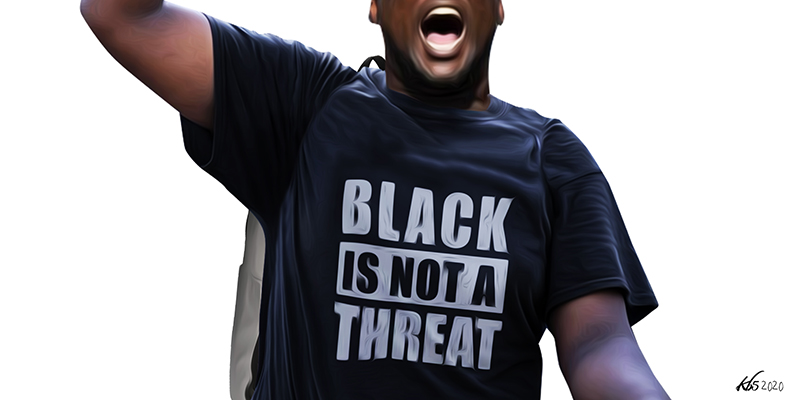Despite the supposed universality of human rights, we are constantly reminded that these ‘rights’ seemingly never quite apply the same way to racialized people.
It is worth highlighting that the Universal Declaration of Human Rights (UDHR) was signed after World War II, at a time where virtually all of Africa was still colonized by European powers, Jim Crow laws were still enforced in the United States and the vast majority of Indigenous peoples could not vote in Canada. Such an omission, in and of itself, may have been the silent admission that universal human rights were not intended to be so universal after all.
The multiple violations of human rights against people of African descent specifically, from the Transatlantic slave trade to the state-sanctioned murders of suspected Haitians in the Dominican Republic, can leave one wondering whether anti-blackness is the oldest and most accepted international foreign policy. Indeed, the UDHR does not seem to apply to people of African descent who still die in droves in the Mediterranean, remain at risks of getting beaten by US border agents as they exercise their right to seek asylum and can get forcibly tested, evicted and framed as carriers of COVID-19 or Ebola without seemingly any breach of human rights frameworks.
The ongoing armed conflict in Ukraine has understandably shaken and shocked an overwhelming number of governmentsand citizens around the world. For many, the last few weeks may very well have been a reminder that history is written in real time and brutality is still the order of international politics. An assault on an independent sovereign country and deadly attacks on civilians – including children – is no longer the distant rhetoric from past historical events but constitute instead a contemporary reality.
NATO country members openly shared that they are “more united than ever” as Russia faces “unprecedented sanctions”. Several NGOs and UN agencies have also immediately joined forces to ensure the safety of the people of Ukraine, illustrating a clear commitment to their human rights and a stand against the invasion of Ukraine overall. The understandable and anticipated condemnation has been swift and unequivocal, even if ineffective so far.
Yet this response has not been equally applicable to non-Ukrainians, particularly people of African descent. Even non-white people fleeing wars and poverty on the continent, or in Syria, Libya, Yemen, Afghanistan are treated with disgust or allowed to drown in huge numbers in the Mediterranean. This nonresponse to the plights of the “Other” shows the cracks in the so-called universal responsibility to protect, while also demonstrating the nonchalance of African leaders who treat their own people as non-beings at home and abroad.
In any event, it would be expected that during an armed conflict, international human rights law would apply for “everyone within the state’s jurisdiction or effective control”. This implies that representatives of the state ought to guarantee everybody’s human rights regardless of citizenship, including their right to safety as per three of the Universal Declaration of Human Rights.
Yet, several videos have circulated showing how African students, and South Asian individuals were denied that very right. Waiting in the cold for hours, threatened to get shot at, denied access onto trains and forced to walk for hours , it appears that these individuals were not to benefit from the very international laws that should protect them at any time.
“They’re not allowing Black people […], they prioritize Ukrainians” shared a witness recounting their experience as they attempted to leave Ukraine. In addition to illustrating a clear violation of international human rights by discriminating people based on their skin color, this sentence speaks to the intrinsic functioning of racial hierarchy. Black people are seen as belonging to the bottom of such a hierarchy: they are existentially understood as the “Other” who cannot enjoy the same rights as the majority. The only conclusion that can be drawn in the face of such accounts: the treatment of Black foreigners and South Asian foreigners within an emergency context is a manifestation of racism and a clear confirmation that the ‘non-western’ is indeed the wretched of the earth, failed by their own governments and the world community.
Further corroborating that conclusion are the neighboring government’s deliberate changes to prevent documentation and paperwork from jeopardizing border crossing for those fleeing the war. As such, for Ukrainian authorities, documentation cannot be used as a premise to discriminate between individuals. The only reference that remains is a phenotypical one and, effectively, the distinction between white people and non-white people was applied. White people, seemingly regardless of nationality, were able to leave without much difficulty.
Evidently, international human rights principles are colour-blind which might be the very reason why they repeatedly fail to acknowledge, anticipate, and address racism. In 2022, after global condemnation of racism following the videotaped murder of George Floyd, the sudden amnesia and denial about racism as a global phenomenon is both disturbing and revealing. Racism is a critical underpinning of the nation-state ideology. As such, in a nation based on homogeneity, in this case European ancestry, so-called “minorities” are racialized individuals for whom the state laws will not be applied the same way. In such a construction, the very fabric of the society is based on a hierarchical treatment between the majority who belongs and the minority who is only tolerated as long as it knows its place.
That very premise – the differential application of human rights towards racialized populations – is constantly left unchallenged despite being constantly corroborated, be it internationally or in internal disparities in police brutality, incarceration rates, and poverty rates in countries such as Canada and US.
On 1 March, 2022, the African Union shared that it was “disturbed” by reports of African nationals fleeing the war in Ukraine and being denied access to neighbouring countries. In keeping with the common habit of using ‘discrimination’ as a euphemism for racism in political statements, the statement also fell short of calling the treatment of African nationals attempting to flee Ukraine for what it was: racism and ineptitude on the part of the African governments.
What does it say then, that both non-African and African governmental bodies alike ignore the obvious plight of people of African descent and other racialized populations?
What does it say that for many, condemning racist practices against African people inherently distracts away the attention from the “real issue”?
These reactions, one could argue, point to the same underpinning: in human rights laws and in the common imaginary, the individual to protect is inherently seen as white and somehow without of a racial identity. It follows that non-White people are still not seen as deserving of rights and protection.
That would also explain, at least in part, the double standards in rhetoric and overall media coverage witnessed since the beginning of this war.
When such a blatant and terrifying aggression could be an opportunity to both renew a commitment to prevent wars and defend human rights for all, it appears that it is currently failing abysmally.
As a result, when facts show that Ukrainian civilians are caught in a terrible war and deserved to be safe and that non-white people are simultaneously subjected to racism by Ukrainian authorities even during the war, there is seemingly no framework to comprehend this horror.
Two manifestations of human rights violations end up pitted against each other in the Olympics of Oppression instead of being analyzed as stemming from a similar ideological ill: the pursuit of domination over a given people. In any case, the observable consequence is that, once again, human rights don’t extend to racialized people and specifically not to people of African descent.
Does it imply then that people of African descent are already perceived as inexistant and that extending human rights to them is seen as unnecessary?
Death of a people and its civilization does not seem to have such obvious characteristics. It is often only in hindsight that one can appreciate the erasure of a people from international frameworks. Complicating that endeavor is the fact that often, Africans themselves only know about their history as told by former colonial powers or by the Africans who ended up assimilating into a supposedly colorless, objective, approach to their own people.
Fanon warned us that “for the colonized subject, objectivity is always directed against [them]”. It must then be concluded that “objective” international human rights cannot possibly apply objectively to African nationals.
The odds are even further reduced when the geographical setting is Europe itself: the colonial “metropole” that normalized the use of astoundingly barbaric methods to conduct their hegemonic ambitions and carry its so-called mission civilisatrice (civilizing mission) for the purported welfare of the “uncivilized African”.
Centuries pass by and yet, it appears that the contempt and compulsive need to invalidate, belittle and dehumanize the non-western Other – in this case, the person of African descent – remains, even in the context of a war.
Evidence piles up and yet, the very authorities that should speak up against the mistreatment of any other racialized people, remain timid.
Again, we ask, what do these reactions (or lack thereof) reveal about international human rights frameworks? What do they reveal about the existence of African people? Where do they belong?
Even on the African continent, it could be argued that laws and political decisions do not protect our existence and the sustainability of our cultures and heritage.
It is estimated that hundreds of pre-colonial African languages are close to extinction and many have already disappeared.Discourses proffering various philosophical approaches to governance and social relations such as Negritude (nativist humanism), Afrocentricity, Pan-Africanism, African Socialism (Ujamaa or familyhood), and Ubuntu (togetherness) have for the most part disintegrated after the fanfare of political independence subsided. The architectural landscape on the African continent counts very few remaining pre-colonial artefacts except for the royal palaces of Abomey in Benin, Rock-Hewn churches of Lalibela in Ethiopia and the Djenné mosque in Mali.
Finally, if we look at the organizations of societies themselves on the continent, whether it is populous centers, the division of labour or existing socio-economic classes, they can all be traced back to an era where the erasure of people of African descent was an explicit political ambition.
Whether it is abroad or on the continent, it seems that no legislative or human rights framework can effectively protect the rights and existence of African people.
As the total disregard for people of African descent is further evidenced, this time in the context of the deadly invasion of Ukraine by Russia, perhaps it is worth considering Issa Shivji’s clarion call for an anti-imperialist reconceptualization of human rights that would ‘unreservedly’ be centred on the collective rights and struggles of oppressed people.
–
This article was first published by ROAPE.







